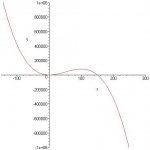Hello!
I am having some trouble with an integral calculus question, can anyone help with some simplification or explanations?
The question goes as follows:
"The vertical deflection y mm of a cantilevered beam is given by:
y= [integral] (F/EI)(Lx-1/2x^2)dx
(sorry I can't copy in the integral sign or the x squared (x^2) symbol)
Where F=load at the free end (N)
E= Young's Modulus of Elasticity (MPa)
I = second moment of area of the beam (mm^4 - again, that's ^4 to the power of 4)
L = length of the beam (mm)
x = distance from the fixed end (mm)
Given that deflection at the fixed end is zero:
(i) Find the deflection of the beam if F=4N, E=2x10^5 MPa, I=1x10^4 mm^4, L=1500mm and x=300mm.
(ii) Write a formula (without integrals) for the maximum deflection of the beam. Hint: A cantilevered beam is like a diving board, fixed at one end. Where on the beam is the maximum deflection?
For the part (i) I simply plugged in the information to the formula given and I get the integral of a number dx. However, the integral of a number is that number times x. But I have no idea what to make of that.
And the second part I have figured that you would replace L with x as the distance from the fixed end is the same as the length of the beam.
Am I on the right track? I would really appreciate some third party insight!
- Monarch.
I am having some trouble with an integral calculus question, can anyone help with some simplification or explanations?
The question goes as follows:
"The vertical deflection y mm of a cantilevered beam is given by:
y= [integral] (F/EI)(Lx-1/2x^2)dx
(sorry I can't copy in the integral sign or the x squared (x^2) symbol)
Where F=load at the free end (N)
E= Young's Modulus of Elasticity (MPa)
I = second moment of area of the beam (mm^4 - again, that's ^4 to the power of 4)
L = length of the beam (mm)
x = distance from the fixed end (mm)
Given that deflection at the fixed end is zero:
(i) Find the deflection of the beam if F=4N, E=2x10^5 MPa, I=1x10^4 mm^4, L=1500mm and x=300mm.
(ii) Write a formula (without integrals) for the maximum deflection of the beam. Hint: A cantilevered beam is like a diving board, fixed at one end. Where on the beam is the maximum deflection?
For the part (i) I simply plugged in the information to the formula given and I get the integral of a number dx. However, the integral of a number is that number times x. But I have no idea what to make of that.
And the second part I have figured that you would replace L with x as the distance from the fixed end is the same as the length of the beam.
Am I on the right track? I would really appreciate some third party insight!
- Monarch.

